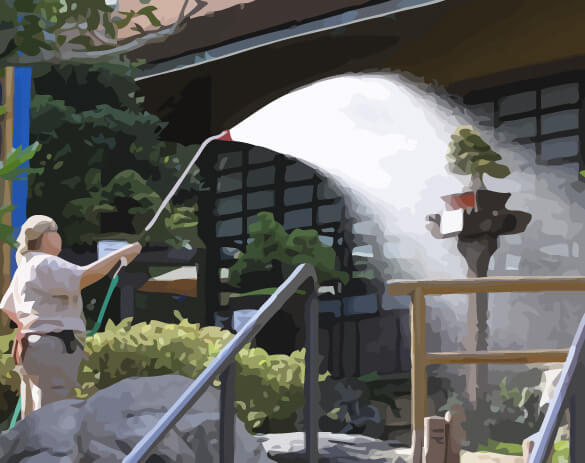Watering and Feeding Bonsai
Table of Contents
Various factors affect the amount of water and fertilizer you should give your bonsai. Some trees are “thirstier” than others. The time of year also affects the quantity of water and nutrients that a tree needs. The type and quality of the potting soil is a factor: the more water and fertilizer that are retained by the soil, the less water and food you need to give the plant, and vice versa.

Watering Bonsai
More bonsai die from unsatisfactory watering than from any other problem. Their roots dry out much more quickly in their shallow pots than if they were planted in open ground. Most bonsai can survive, if not thrive, when grown in an inadequate soil without added nutrients, but if they do not have water they will soon dehydrate and die.
Usually, you need to water bonsai daily in spring, summer, and autumn. In winter, dormant trees kept outside in the rain and snow need little extra watering, but make sure that any specimens kept in a cold frame or unheated greenhouse do not dry out. Continue to water any tropical and sub-tropical bonsai indoors, because they will keep on growing throughout the winter, although at a slower rate than in summer, and need to be kept constantly moist.
How to Water
Water your bonsai in the evening after sunset. The moisture will then be retained in the soil and available to the roots all night and into the next morning. If you water in the morning, the soil may dry out completely within a few hours; also, any water splattered on the leaves during daytime watering can act as a lens for the sun's rays and cause leaf scorch.
Water from above, using a watering can or one of the many hose spray nozzles with fine holes attached to a hose. You can purchase sprinklers and cans especially designed for bonsai work. The watering can needs a long neck to create a sufficient “head” of water for the spray. If the tiny holes of the hose nozzle get clogged, it’s easy to clean by simply removing it from the hose.
Feeding Bonsai
It is essential to feed your bonsai for good growth; if you do not, they may not die, but they certainly will not flourish.
From spring to the fall, it is customary to apply a general, balanced fertilizer; many successful growers use nothing else. In the fall, it is advisable to switch to a fertilizer high in potassium and phosphorus, but low in nitrogen, because it is then that the tree's growth rate slows and they start to become dormant. When growing Rhododendron cultivars (azaleas), Enkianthus, stewartia, and other lime-hating plants, choose an ericaceous fertilizer specifically created for such plants.
The main elements in any fertilizer are printed on the packaging in the order NPK (N for nitrogen, P for phosphorus, and K for potassium). A typical autumn formula is in the ratio 0:10:10. Always follow the instructions on the packet; it is not worth buying such a specialized product if you deliberately interfere with its effectiveness.
Fertilizer Types
There are many brands of fertilizers on sale, although their names may vary. You can choose between liquid or solid fertilizers. Solid fertilizers come as powder, granules, or small cakes or blocks. Buy granules if possible: they take several weeks to break down, and each time it rains or you water the bonsai, a little more fertilizer dissolves. The granules remain visible on the soil, thus reminding you when it is time to add some more.
Liquid fertilizer acts more quickly, but it is more difficult to see just how much has been absorbed. Heavy rain just after you have applied the product may wash the nutrients through the soil before the plant has absorbed them. The same problem applies to the powder form of solid fertilizer.
Japanese growers frequently add nutrients in the form of small blocks or cakes of rape seed or fish meal. These break down slowly in the same way as fertilizer granules, but do not look attractive on the soil. They can also act as a breeding ground for maggots.
839GYLCCC1992




Leave a Reply